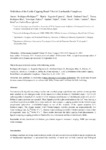Definition of the labile capping bond effect in lanthanide complexes

Use este enlace para citar
http://hdl.handle.net/2183/18354Colecciones
- Investigación (FCIE) [1228]
Metadatos
Mostrar el registro completo del ítemTítulo
Definition of the labile capping bond effect in lanthanide complexesAutor(es)
Fecha
2017-01-23Cita bibliográfica
Rodríguez-Rodríguez, A., Regueiro-Figueroa, M., Esteban-Gómez, D., Rodríguez-Blas, T., Patinec, V., Tripier, R., Tircsó, G., Carniato, F., Botta, M., Platas-Iglesias, C. (2017), Definition of the Labile Capping Bond Effect in Lanthanide Complexes. Chem. Eur. J., 23: 1110-1117. https://doi.org/10.1002/chem.201604390
Resumen
[Abstract] Two macrocyclic ligands containing a cyclen unit, a methyl group, a picolinate arm, and two acetate pendant arms attached to two nitrogen atoms of the macrocycle either in trans (1,7-H3Medo2 ampa = 2,2′-(7-((6-carboxypyridin-2-yl)methyl)-10-methyl-1,4,7,10-tetraazacyclododecane-1,4-diyl)diacetic acid) or in cis (1,4-H3Medo2 ampa) positions are reported. These ligands provide eight-coordination to the Ln3+ ions, leaving a coordination position available for a water molecule that occupies a capping position in the twisted square antiprismatic polyhedron (1,4-H3Medo2 ampa) or one of the positions of the square antiprism (1,7-H3Medo2 ampa). The charge neutral [Gd(1,7-Medo2 ampa)] complex presents an unprecedentedly low water-exchange rate (kex298=8.8×103 s−1), whereas water exchange in [Gd(1,4-Medo2 ampa)] is three orders of magnitude faster (kex298=6.6×106 s−1). These results showcase the labile capping bond phenomenon: A ligand occupying a capping position is hindered by the environment and thus is intrinsically labile.
Palabras clave
Density functional calculations
Gadolinium
Magnetic resonance imaging
NMR spectroscopy
Water exchange
Gadolinium
Magnetic resonance imaging
NMR spectroscopy
Water exchange
Versión del editor
Derechos
This is the peer reviewed version of the following article: Rodríguez-Rodríguez, A., Regueiro-Figueroa, M., Esteban-Gómez, D., Rodríguez-Blas, T., Patinec, V., Tripier, R., Tircsó, G., Carniato, F., Botta, M., Platas-Iglesias, C. (2017), Definition of the Labile Capping Bond Effect in Lanthanide Complexes. Chem. Eur. J., 23: 1110-1117, which has been published in final form at https://doi.org/10.1002/chem.201604390. This article may be used for non-commercial purposes in accordance with Wiley Terms and Conditions for Self-Archiving.
ISSN
0947-6539
1521-3765
1521-3765





